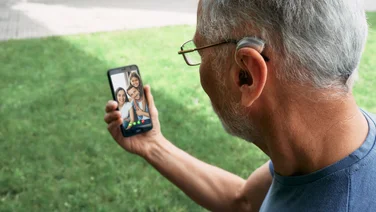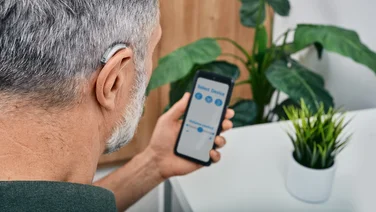To help us provide you with free impartial advice, we may earn a commission if you buy through links on our site. Learn more

Bone anchored hearing aids, or BAHAs, deliver hearing aid technology to those people who can’t or won’t wear hearing aids inside their ears. Attaching just behind your ear, these small devices work directly with your inner ear, using your body’s natural ability to conduct sound through bone – delivering clear, natural sound while leaving your ears free of devices, tubes and wires.
The term “bone anchored” may sound grisly, but these small implants are attached under local anaesthetic in a reversible procedure that usually takes less than an hour. The biggest hurdle is likely to be the cost, compared with other hearing aid types. Prices vary depending on factors including the type of hearing loss and your location, but currently a bone anchored hearing aid can cost from around £4,000, not including hospital fees.
BAHAs are more expensive than any other types of hearing aid, so choosing this option is a significant commitment. In this in-depth guide to bone anchored hearing aids, we explore who might benefit from these devices, explain how they work, and lift the lid on costs.
Looking for hearing aids that match your exact requirements? You can use our free quote finder tool to be matched to a local hearing aid specalist.
Get a free quote for hearing aids today
Save yourself some time (and money): take our quick survey below and we’ll match you with a hearing aid supplier that suits your needs.
Is a bone anchored hearing aid right for me?
A bone anchored hearing aid bypasses your outer ear and ear canal, making it a useful option for people who struggle to wear other types of hearing aid – or whose hearing loss doesn’t respond well to standard behind-the-ear (BTE) or in-the-ear (ITE) hearing aids.
A BAHA is worth discussing with your audiologist if you…
- Have conductive hearing loss, which means sounds are unable to pass from your outer ear to your inner ear because of a blockage such as earwax, glue ear or a build-up of fluid from an ear infection;
- Suffer frequent ear infections, allergies or other problems with your ear canal that prevent you from wearing conventional hearing aids;
- Suffer from middle-ear disorders or congenital defects. These can prevent sound conventional hearing aids passing through your middle ear to your inner ear;
- Lost your hearing as a result of perforated ear drums, which can again prevent sound from passing through your ear in the conventional way;
- Are profoundly deaf in one ear;
- Find that conventional hearing aids don’t deliver sound as clearly as you’d like, or you dislike the sensation of wearing an aid in your ear.
How do bone anchored hearing aids work?
Bone anchored hearing systems are made up of three parts: a small titanium implant that’s surgically attached to the bony bit just behind your ear; a titanium abutment that attaches to the implant; and a sound processor that attaches to the implant.
Once the sound processor is clicked onto the implant, it works much like a conventional hearing aid. However, instead of sending sound via the ear canal, it transforms sound waves into sound vibrations that transmit through your skull bone. This is the reason bone anchored hearing aids are often called “bone conduction systems”.

This bone conduction process is how your body naturally transmits sound. It also helps to keep the ear canal dry and healthy, reducing the risk of infection and avoiding the discomfort of having something blocking your ear.
The processor clicks on and off easily and comfortably, so wearers generally remove them at night, or whenever they don’t need to receive enhanced sound.
READ NEXT: How do hearing aids work?
How good is the sound from bone anchored hearing aids?
Many users find that the sound delivered via a bone anchored system over a conventional hearing aid is clearer. There’s no skin, earwax or middle-ear blockage to dampen the vibrations, which instead transmit directly through your skull bone straight to your all-important inner ear.
Like other types of hearing aid, BAHA sound processors come with all the usual adjustments that let you tweak their performance to get the right level of sound for you.
What do bone anchored hearing aids look like?
What you see on someone wearing a BAHA is the sound processor, which is essentially the hearing aid part of the system. It looks a bit like the outer part of an earbud. The implant and abutment aren’t visible unless you have very short hair or no hair at all.

Manufacturers are competing to create ever smaller, more discreet BAHA sound processors. The one the man is wearing in the photo at the top of this article is the Oticon Ponto 4, which Oticon describes as “the smallest bone anchored sound processor ever”. It’s unlikely to be visible to other people if you have thick or curly hair.
Of course, not everyone is bothered about hiding their BAHA device, which many regard as a pretty cool type of hearing aid. If you want to wear your sound processor loud and proud, plenty of BAHA providers offer statement designs and vibrant colours.
What is bone anchored hearing aid surgery like?
It’s quite a simple procedure, much like going to the dentist, and is usually performed under local anaesthetic as an outpatient.
We’ve seen some providers say they can get the whole thing done in 20 minutes, which seems rather quick to us; others say to allow up to an hour. During the procedure, the surgeon makes a small incision behind your ear for the implant, then inserts it surgically through the skin and a few millimetres into the bone. The abutment then attaches to the implant.
You don’t need stitches, but the implant needs around four to 12 weeks to heal before you can go back to the audiologist to have the processor fitted and adjusted to suit you.
Can I have a bone anchored hearing aid without the implant?
Yes. There are an increasing number of instant-fit bone conduction hearing systems now available that attach to headbands, the arm of your glasses, or even to your scalp using special adhesive.
For instance, Adhear (pictured below) is a non-surgical bone conduction hearing aid that sticks to the skin just behind your ear and conducts sound straight through your bone. It’s as visible as a BTE hearing aid, but like a BAHA implant it avoids the need to wear anything in your ear canal.

BAHA manufacturer Cochlear has also launched an instant-fit bone anchored hearing aid, the Baha SoundArc, part of the Cochlear Baha Start range for children and adults. This time, the sound processor attaches to a discreet headband that looks much like a Bluetooth running headband:

There’s even an Etsy store that sells special BAHA headbands and hats for kids. BAHAAccessoriesUK is UK based and boasts a five-star rating.
However, it’s important to note that instant-fit bone anchored hearing aid options don’t deliver quite the same results as BAHAs with an implant. This is because your skin acts as a sound insulator, whereas bone acts as a sound conductor.
Are bone anchored hearing aids the same as cochlear implants?
No. They both have external sound processors so they look similar, but they’re very different devices. A BAHA is a hearing aid for people with hearing loss, while a cochlear implant is an electronic “sound substitute” for people with profound deafness. It uses internally implanted electrodes to stimulate the auditory nerve and trick the brain into “hearing” sound.
Cochlear implants are far more expensive than bone anchored hearing aids. Anyone who’s seen the 2019 film Sound of Metal may remember Riz Ahmed’s profoundly deaf character receiving a cochlear implant, and selling his worldly belongings to pay for it.
How much do bone anchored hearing aids cost?
Bone anchored hearing aids cost around the same as a high-end hearing aid, with prices starting at about £4,000 for a sound processor and implant.
BAHA manufacturers and providers are reluctant to reveal their device prices. This is because the exact price you pay will depend on many factors including your level of hearing loss and your location. Leading provider Oticon Medical explains in the Cost section of its website that it all depends on your needs, and invites you to get in touch for a quote. To get quotes from a number of providers so you can compare them, use our quote-finder tool.
UK organisation CHEARS (Children’s Hearing and Amplification Resource) offers a rough idea with its downloadable guide to hearing aid prices, which includes those for BAHA systems. They put the Cochlear Baha bone anchored hearing aid for adults at £3,400, and a “contact mini” BAHA-type device for children at £900.
Prices can rise much higher than that in line with the power and functionality of the sound processor, which is essentially the hearing aid part of a BAHA system. You pay more for advanced audio features and settings such as multiple noise levels, sound environments, wireless connectivity and mobile streaming.
Accessories are much easier to price up. A Cochlear Baha Remote Control, for instance, costs £253 including VAT from UK audio manufacturer Connevans. An Oticon Medical Streamer, which lets Oticon BAHA wearers stream audio from phones, computers and so on in greater clarity, costs £242.
How do I choose the best bone anchored hearing aid for me?
If you’re interested in finding out more about bone anchored hearing aids, chat to your audiologist or to an ear, nose and throat (ENT) doctor. They will be able to test your hearing and assess whether you’d be a good candidate.
Use our quote-finder tool to find out what type of hearing aid would best suit you, and to discuss the best options for helping you hear more easily and clearly.






